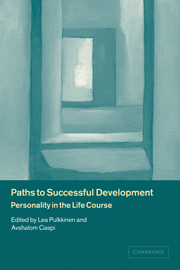Book contents
- Frontmatter
- Contents
- List of contributors
- Personality and paths to successful development: an overview
- Part I Temperament and emotion regulation
- Part II Formation of social relationships
- 3 Attachment relationships and appraisal of partnership: from early experience of sensitive support to later relationship representation
- 4 How do adolescents select their friends? A behavior-genetic perspective
- Part III Continuity in individual life paths
- Part IV Environmental contributions to personality development
- Part V Life transitions
- Part VI Personal goals and well-being
- Index
- References
3 - Attachment relationships and appraisal of partnership: from early experience of sensitive support to later relationship representation
Published online by Cambridge University Press: 22 September 2009
- Frontmatter
- Contents
- List of contributors
- Personality and paths to successful development: an overview
- Part I Temperament and emotion regulation
- Part II Formation of social relationships
- 3 Attachment relationships and appraisal of partnership: from early experience of sensitive support to later relationship representation
- 4 How do adolescents select their friends? A behavior-genetic perspective
- Part III Continuity in individual life paths
- Part IV Environmental contributions to personality development
- Part V Life transitions
- Part VI Personal goals and well-being
- Index
- References
Summary
Introduction
Part of Bowlby's developmental writing focused on the accumulation of empirical evidence towards the most far-reaching hypothesis provided by psychoanalysis, namely, that the mother-child relationship has profound influences on the psychological development of the child well into adulthood (Bowlby, 1969/82, 1973, 1979). Bowlby saw a strong relationship between an individual's experience with his parents and his later capacity to make affectional bonds (Bowlby, 1987). The major goal of this chapter is not only to provide support for the viewpoint that attachments are a life-long concern, but also to argue for the influence of the child's early attachment experiences and representations on his or her later partnership representations. In support of this argument, we will demonstrate three pathways from infancy to young adulthood that point in the direction of the quality of later partnership representation. They are as follows: a) maternal sensitivity turned out to be a strong predictor even from the earliest assessments on; b) attachment assessments in childhood and adolescence but not in infancy predicted later partnership representation; and c) assessments of discourse quality about attachment issues made a unique contribution to the prediction of later partnership representation. The three pathways were closely interrelated suggesting that the roots of adult partnership representation can be found in interactive assessments, in discourse, or in standard assessments of attachment.
- Type
- Chapter
- Information
- Paths to Successful DevelopmentPersonality in the Life Course, pp. 73 - 105Publisher: Cambridge University PressPrint publication year: 2002
References
- 27
- Cited by

